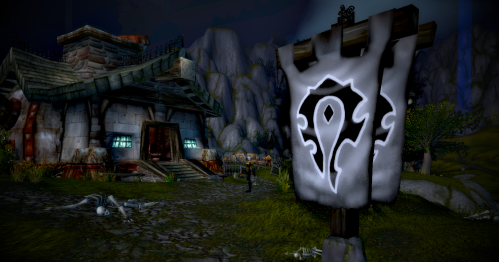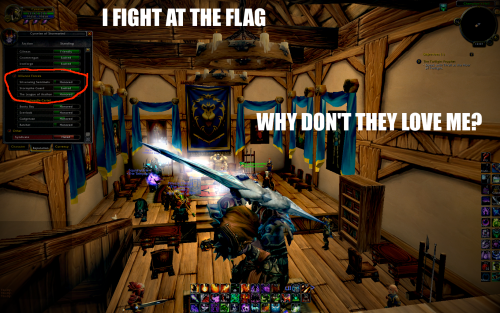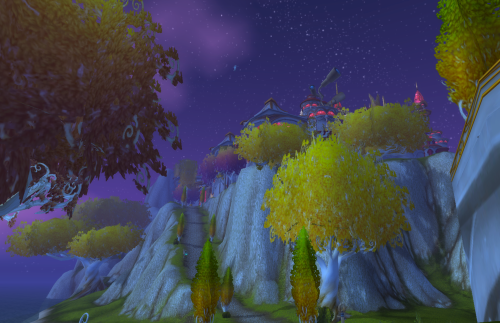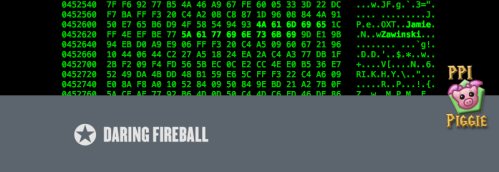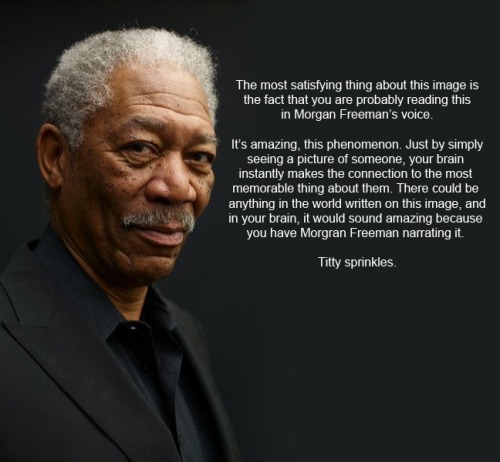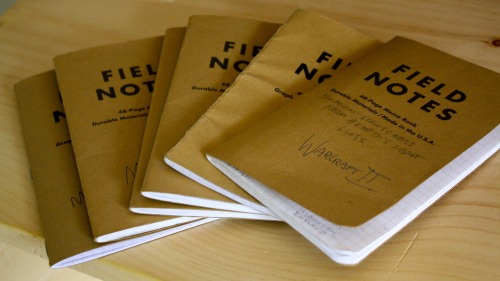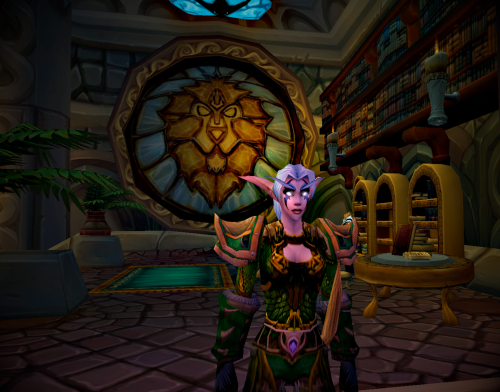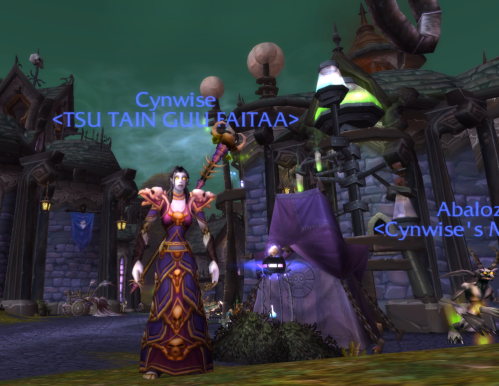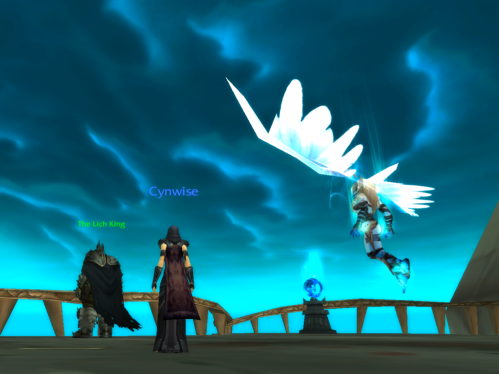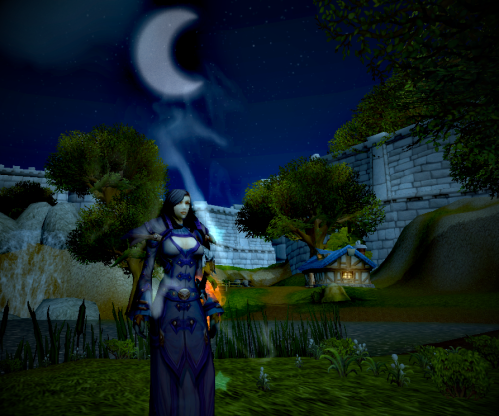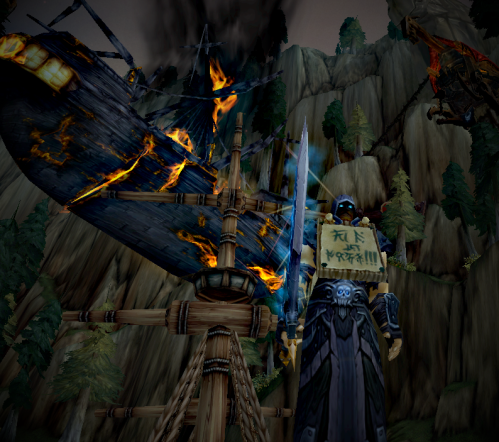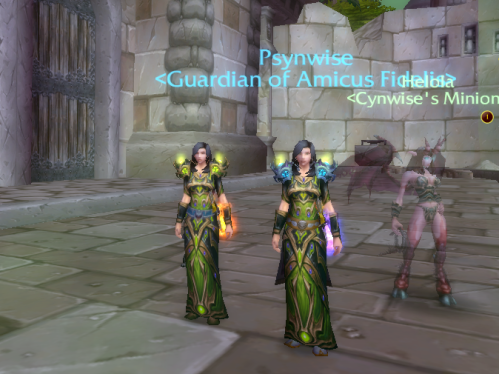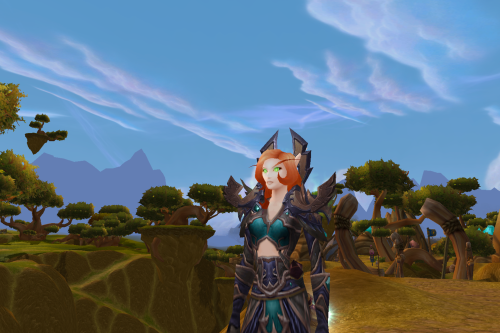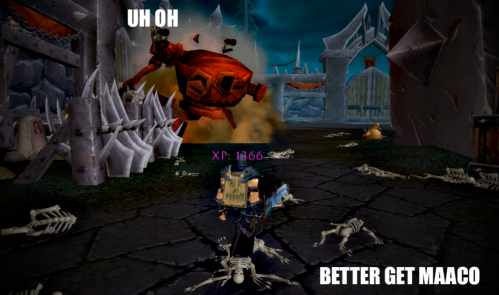Your avatar can look any way you want it to, up to the limitations of your equipment. If you’re ugly, you can make your avatar beautiful. If you’ve just gotten out of bed, your avatar can still be wearing beautiful clothes and professionally applid makeup. You can look like a gorilla or a dragon or a giant talking penis in the Metaverse. Spend five minutes walking down the Street and you will see all of these.
– Neal Stephenson, Snow Crash
Snow Crash, one of Stephenson’s early works from 1992, is a classic of the cyberpunk genre. It’s fully developed in a way that earlier entries in the genre (c.f. Neuromancer) were not, with a solid adventure story mixed in with cyberpunk distopian musings on technology. There are a lot of elements that strike false chords now from this 20-year old work – I simultaneously giggle and sigh regretfully when he talks about hypercards – but there’s a lot of really interesting predictions in there, especially about the Metaverse, an avatar-driven version of the Internet and key alternate setting for the story.
Fiction subgenres seem to go through this a lot, where the first entry is groundbreaking in idea and scope but might be of varying actual quality, subsequent entries are more nuanced but still settling in to what the genre means, until finally the formula is established and authors can churn out books in an established, comfortable setting. Snow Crash will ruin Neuromancer for you, but Stephenson couldn’t have written it had Gibson not made the first move. You should read both books, but remember that Neuromancer came 8 years earlier, in 1984, and that both the computing landscape and the cyberpunk genre were very different when these works were composed.
When Blizzard announced cross-realm raiding and rated battlegrounds would be coming to Warcraft, my first thought was of how Blizzard – by addressing the technical problems that separates players from interacting with each other – is moving towards recreating Stephenson’s Metaverse, and of how social networks on the internet are really the keys to their success.
It’s not about raiding.
It’s not about PvP.
It’s about virtual identity and social interaction.
And for all the troubles that advances like cross server random battlegrounds and LFD have caused, they laid the groundwork for something great, something unexpected. Something much bigger than a video game.
VIRTUAL YOU
Virtual presence is a funny thing to really think about deeply. I mean, here I am – meatspace Cyn, a human being typing at a computer. Because of the pictures and words I’ve chosen to represent myself with, you – a human being reading these words on the screen – have an idea about who I am, or who I present myself as being, at least. Even in the most passive kind of relationship, author and reader, there’s a flow of information going on between two people across time and space. That’s what books do. “There is a young lady sitting in a wooden chair. A glass of water sits, untouched, on the table beside her, sweating in the humid night air.” BOOM, I have just sent you an image across time and space. That’s pretty awesome.
The internet changes this relationship by closing the feeback loop. The passive relationship becomes a potentially active one, with readers taking part in the conversation and becoming authors themselves. Personal web sites begat weblogs, which in turn begat comments, which spread to Facebook and Twitter and Flickr and a host of other ways for people to talk to each other. It can stay passive – often is passive – but the technology makes it possible to easily close the feedback loop and turn a reader into an author. Consumers become producers. Dialog happens.
Cynwise is only one aspect of my virtual self, albiet my best-known one. I exist, in different ways, on different networks – I’m a wildlife photographer on Flickr and a PvP warlock on Twitter, and those parts of me can be as separate or combined as I choose. I can blog under different names, and they’re all still virtual me, but separate and distinct from themselves. Different channels allow for different avatars. This is one of those things I think cyberpunk novels didn’t anticipate in the ’80s and ’90s, how fragmented cyberspace would be. The concept of a monolithic, single environment like the Metaverse is somewhat sunk in the techology of the time, and didn’t anticipate the wild democratization of the Internet which happened in the late 90s/early 00s. They may have anticipated Netscape, but they didn’t expect Javascript or Ruby on Rails to come along with it. The technoelite proved to be broader and wider than expected (and that’s a good thing.)
I find it interesting slotting Warcraft into this milieu of online social networks.
IS WOW A GLORIFIED CHAT CLIENT, OR SERIOUS INTERNET DRAGONSLAYING BUSINESS?
(Or, false dichotomy.)
I’ve heard WoW called “a chat client I was paying $15/month for.” This is almost always in reference to quitting WoW, and it strikes me as both brutally honest and unfair at the same time. It’s honest because it can be just that – a chat client. That comment is often accompanied by stories of standing around in Dalaran, or doing laps in Dalaran, or doing other things that give the Dalaran Board of Tourism and Commerce hives. Something about Dalaran.
It’s brutally honest to realize what you’re doing, which is to log in to a video game to talk to people because you don’t feel motivated to “play” the game – i.e. have your avatar do things. You just want to get in and talk to folks, which, to be honest, you can do for free using a variety of other social network tools on this newfangled Internetthingy we have.
It’s a rational cost decision to quit WoW at that point. Why should you go and pay $15/month to use a chat client when there are free options? I wouldn’t, and I’m almost positive you wouldn’t, not if that’s all it was. Get on Facebook or Twitter. Visit your guild forums. Use Skype. Sit in Vent and chat with folks. All of these are zero-cost social media networks which can be used to talk with people, and while it’s not the same as doing things with them in the virtual world, if you weren’t really doing those things anyway, why spend the money?
The unfairness comes in the false dichotomy presented with the question at the top of this section, though. It’s not that WoW has to be either a chat client or serious internet dragonslaying business. It’s not like someone said, hey, we notice you’ve stopped raiding, how about you try this somewhat cumbersome text chat client with a severely limited participant pool? Hope all your friends are on this server / playing this faction / in your guild / haven’t turned trade chat off!
No, the social network is there no matter what. It doesn’t matter what you’re doing within the game, as an MMO it is designed to reward social experiences. PvP, PvE, auction housing, even leveling and questing – you are in a virtual world populated with other people.
WoW is a simple social network with a video game bolted on top of it.
That’s really weird to say it that way. It’s an inversion of the normal way we look at WoW, and even how it was developed. WoW is a video game, right? And there are video games you play by yourself, and games you play with others. And those games you play with other have social media “tools” bolted on to them – Real ID / Facebook integration, anyone – but at their heart they’re a video game. Talking to other people is a side effect of having multiple players, not the core functionality of the game. It’s not like Farmville, where Blizzard said, hey, let’s use an existing social network site and build a video game around it.
(If they had, the flaws in WoW’s social network might not be so problematic. But I digress.)
I don’t think it was Blizzard’s intention to make a social network. I’m honestly not arguing that. But I think that what they’ve created has inadvertently become one, a powerful one at that, and that many of the changes we have seen in the last 3 years have been Blizzard and the WoW playerbase trying to come to grips with this fundamental paradigm shift.
Hear me out.
Simple video games don’t bother with an avatar. You interact directly with the controls and jack straight in; there’s no digital representation of you in the mix. If I start a game of Solitaire on my computer, I don’t go through and pick which player best represents me. That’s irrelevant to the actual gameplay and is (rightfully) discarded. These games can be incredibly complex, and even drop you into a story as an actor (like Zork or Myst), but there’s no avatar required. It’s all first person or second person.
Avatar-driven games get more interesting. You make characters, you present a face to the game. You may not be trying to represent yourself – think of all the different Shepard models – but this thing, it represents me, it is me in the game. It could be a car in a racing game, or a character in a fighting game, or multiple characters in a RPG – but as soon as you add an avatar, players are now able to say that is me.
Things get a hell of a lot more interesting when you add other players to the mix. Now, you have me and you and you and you and you. Maybe it’s just the two of you, so the avatar requirements are pretty simple. I don’t need a digital avatar to play Words with Friends on my iPhone – a username will do. But that username is an avatar. It’s important to remember that. Names are simple avatars, icons more complex, actual humanoid creatures even more complex, spiraling exponentially to the very fungible reality Second Life presents.
But for most video games, the avatar isn’t the point. The game is the point. The objectives and goals and gameplay within the game is the purpose of the game. This is startlingly different from a social network like Twitter or Facebook or Google+ or even weblogs, where the interaction between avatars is the point. That’s why Twitter seems so effing pointless when you first pick it up – what am I supposed to do with it? Talk to … who, exactly? About … what? What I had for lunch? You are given a blank tool with no real direction about how to find people with similar interests or who you find entertaining or useful or … wait, why did you sign up for Twitter? Was it to get short news updates, to keep up with celebrity gossip, or to chat about video games?
Video games provide purpose and direction. Social networks do not, letting the user determine what they want out of the service.
Avatar-driven video games provide a means for virtual projection, for assuming a virtual persona. And if they allow you to actually interact with other players, well, then they start functioning just like a social network, albiet a constrained one. Your avatar choices are limited, but perhaps more detailed. Instead of a picture of … anything, you have to pick a specific kind of wizard or spaceship captain. Your interactions can be confined in game – perhaps there aren’t global chat channels, and you have to move your avatar to places to interact with other players. Pure social networks try to reduce this interaction friction, make it as easy as possible (since that’s their sole purpose), but games might have different priorities.
Let’s take a limited interaction in WoW as an example. I logged in to my Horde priest, saw my keybinds were screwed up and that I really had to spend some time straightening them out to get the character playable again. I said hi to my guild, saw a friend of mine was online in a nearby zone – Nagrand. She was grinding rep, so I figured I’d swing by and fiddle with my keybinds in a beautiful zone, since Nagrand is seriously the prettiest place in Warcraft. I got a basic keybind settled, hit up one of the guards at Halaa to try it out (really high health, low damage, perfect training dummy) while chatting with folks.
About 10 minutes later my friend swings by on her warrior and tanks the Halaani guard for me. It was probably a second guard, they eventually die after like 15 mintues of Smite Smite Smite SCREAM Bubble Smite Smite Smite Smite WINGS, but that kind of practice is actually really good for settling your keybinds. We continued a conversation we’d had earlier over Twitter, and after a bit I needed to go so she went back to grinding Mag’har rep.
The details of the story don’t really matter – it could have been helping a friend run a lowbie through an instance, running heroics with guildmates, doing Arenas with partners – because so much of Warcraft is predicated around things like this, doing things with other people. You have social interactions all the time. The advantage Warcraft has over Twitter is that you can do stuff with people while talking to them. You can go play a video game with people while chatting with them! You can have a real avatar, one that like moves and talks and walks and can wear clothing and kill Internet Dragons! Holy moly, that’s radical shit!
I’m not being sarcastic, either. It’s pretty radical shit. You have a social network which not only allows, but encourages you to go do stuff with other users of that network. You want to just stand around and talk? That’s cool, you can do that. But you can also go run a dungeon together. You can go stage a dance contest in Thunder Bluff and get angry at the Tauren constables for running you out of town. You can go invade the opposite faction’s capitals – or maybe just Crossroads. You can queue up for battlegrounds or dungeons or even raids now with people you know.
That’s something Google+ hasn’t implemented yet. Neither has Twitter. And Facebook’s graphics engine is totally shit.
Listen, I know. Cyn, it looks like a duck, it quacks like a duck, it flies like a duck, it’s a duck for crying out loud. Saying that WoW isn’t a video game is … well, yes, it’s a video game.
But just try this the next time you log in: look around at what you’re doing, and think of it differently. Think of it as a social network that lets you do cool things (KILL INTERNET DRAGONS) while interacting with other people. Friends, hopefully, but strangers (potential friends?) too – see how much of the game is really oriented around that goal of doing stuff with other people. When you’re buffing for your first pull on raid night, realize that you’ve connected a group of 10/25 people together over voice and text chat, all to play a game together. When you log in to your guild, don’t just look at it as your guild, but as an exclusive chat channel, of a Friends/Followers list that you don’t have all that much control over.
When you take away the social aspect of WoW, it’s just a single player video game. And eventually you’ll get tired of it and move on, because there’s nothing to really keep you in it.
Your avatar means nothing without other people.
BBSES, COMPUSERVE VS AOL, SERVER COMMUNITIES, LFBG/D/R AND WALLED GARDENS
It was 1987 and I was a BBS nerd. I knew this guy who knew a guy who ran a system up in Ridgefield with 4 (count them FOUR) 9600 baud modems hooked up to a BBS. It was a place where there were message boards about comics and D&D and computers and it was basicallly nerd heaven. I was … I was named after a famous comic book hero, let me just leave it at that. It was my first online handle and I’m not proud, but I was also 13, so I have an excuse.
The technical limitations of that server, no matter how cool the fucking hardware was, were pretty severe. That was true of all BBSes – you had to know the number to call, you had to create a user account just there, the sysop had to approve you and grant you access and then you had to check back periodically by dialing into the system. The internet was something bigger than that BBS, kind of talked about but not really known about. Accessing the internet was free, and there wasn’t a lot you could *do* there – while this BBS had stuff going on. Local comic shop news? D&D games looking for players? SIGN ME UP.
We told a lot of stories on that BBS, collaborative stories, some play-by-forum RPG games too. It may have been primitive, it may have been text based, but in many ways it satisfied a lot of the social needs Warcraft fills for me now – it let me do stuff with friends. Most of the were friends, at least – it’s not like a 4-line BBS could have thousands of users.
I know it sounds hokey, but that BBS was really cool to me. Yes, it was isolated – it served like 7 little towns in Connecticut. It wasn’t connected to other things. But there was a great little community going there, something that shouldn’t be extrapolated out to “this was BBS culture,” but “this was COMLINK, and this is a cool place to be.”
Yeah. Comlink. Don’t laugh. It was the 80s, we all get a fucking free pass for the entire decade.
Compuserve and AOL came into my life a little later, though Compuserve existed before then. Compuserve had banks of modems around the world that you could dial into and access their systems, a model that AOL copied and became huge and successful with. I used both, but mostly AOL later on when I dropped out of college. Especially early on, both services presented a walled garden to users – content hosted within their servers, theoretically vetted by their moderators, to contrast with the internet that was shaping up “out there”. In some ways they were like a BBS writ large, with forums and chat rooms and mail and content pages – holy crap, do you remember “Visit Keyword: X” before URLs became mainstream? – and there was a war going on between these two services, one being perceived as family friendly, the other more business oriented, both of them relying upon access fees and walled gardens of content to convince people to hook up their computers to their computers and give them things to do.
The internet was scary, it was difficult, but it was also the wave of the future. People were figuring out how to use it in the late 80s and early 90s, back when Compuserve connecting email to the Internet was a BIG FUCKING DEAL. Shit, as late as 1998 I was working at an place where one of our major selling points was email integration to the internet from a Lotus Notes network. Jesus Christ, I can’t believe we used to have to have clever internet gateways just to send an email outside of our little sandbox.
As time went on, however, the internet (specifically the HTTP and SMTP protocols, and the allmighty TCP/IP stack) became the de facto standards for communication between computers. Netscape changed a lot of this, to be honest. The walled gardens AOL and Compuserve provided were no longer the only places to visit on the web. People started saying, wait, why should I go through this proprietary gateway to get to the places I really want to go? Why should I have to pay for X content when it’s out there on the web for free? What about all those companies who offered their services solely on AOL (“Visit Keyword: JCPenney!”), what about the lost revenue by not having their stuff available for the wider web?
Other companies got in the act and began offering access without the walled garden, and while AOL and Compuserve managed to survive and make profits during that time (mostly by making internet access seem daunting, then providing a relatively simple solution), by the late 90s the internet was the thing, not the walled garden. The internet was where Everyone was, with global reach. All the promises of Cyberspace and the Metaverse were not to be found behind the high walls of the CIS compound or the towers of AOL – no, they were out there in the raw HTML floating around on the mutated bones of ARPANET.
The history of these services and how they connected people is entirely relevant to looking at the state of Warcraft today.
The limitations of technology restrict our individual social circles, that’s a self-evident truth. When long distance was expensive, we didn’t call across the ocean; now that we have VoIP, video calls around the world can be made for free. Technology breaks down geographic barriers in this way. When I was on a BBS, I could interact only with other geeks a few towns away. The internet’s global reach lets me talk to you, now, nearly anywhere in the world.
Warcraft has struggled because the technology for video games – how do I display this avatar, how do I display an internet dragon, how do I make them fight – has lagged significantly behind social network technology. It’s not because it’s being developed slower, games just require so much more hardware that limitations are in place which make no sense in light of modern social networks.
Pre-battlegroup servers were the BBSes of WoW. You had to have an account to play there, you could only interact with people on that server, which led (in turn) to highly specialized server subcultures. The social network was limited in size, and like any small community, standards of behavior got enforced. You knew the players you played with. You interacted with them all the time. PvP players knew their opponents because they played against each other all the time.
But there are problems with single, isolated servers. Faction imbalances are heightened, as one side may be demonstrably superior. Some servers just aren’t very good, while others are overcrowded. Instanced battlegrounds could take hours to get a game together, because it all depended on server population and playstyles.
These are legimate problems Blizzard faced with single servers. And, approaching it like a video game company, they set out to make their game more fun.
Battlegroup servers were the Walled Garden phase of WoW’s development as a social network. By bridging the gaps between servers – first with linked battlegrounds, then arena teams and battlegroups, then random bgs, then finally LFD in Wrath – Blizzard took steps to fix a huge problem with their game. People wanted to do activities, but getting a group together to do it was difficult. PvP was the place to start not only because it was lower participant population than PvE (and therefore longer queues, but because of the faction communication barrier, it was impossible for players to effectively coordinate this on their own in-game. Servers got imbalanced, factions got imbalanced, but if you could broaden the pool of players enough, then the inconsistences would even out in a statistical wash.
There were serious technical barriers that Blizzard had to work with to solve this issue, which is why the battlegroup system (based on data center) was used instead of a game-wide system. Network speeds and computing speeds had to get fast enough to allow players on different servers to interact without major latency on the server sides. As the techology improved, Blizzard could move servers out from BBSes to little walled gardens, where a dozen servers got together to bash skulls in with PvP.
The introduction of cross-server LFD was a big deal, but honestly, it was a logical outgrowth of the battlegroup innovations for BGs and PvP. Once you start connecting computers together, you can’t go back.
(Aside: I think it would be really interesting to plot out the rise of Facebook, Twitter, and Google+ chronologically against the social developments in WoW over time.)
Post-battlegroup/RealID servers are the current phase of WoW’s social network. The BBS community of each server is long gone, but RealID is the death blow to the walled garden phase of WoW – though that phase will be a long time in dying. Friend is on a different server? No problem! First BGs and 5 man dungeons, now rated BGs and old raids, eventually questing, Arenas, and current raids will be possible with RealID.
Mark my words; you will be able to do just about everything with a RealID friend on a different server as you can with a regular player on the same server. Interacting with the world – questing – will be the most difficult, because you have to figure out which server is “home” – but it’s going to happen. We’ll probably see arenas first, then questing, and then – only when people are used to the idea that the walled garden is really gone – will they enable cross-server current raids.
The trend in technology is to broaden reach and allow choice. Social networks are a bit ahead of the curve, but make no mistake – as an MMO, Warcraft is a video game bolted on top of its own social network, and it’s not just competing against SW:TOR or RIFT – they’re all competing against social media.
BATTLETAGS, OR WHY BLIZZARD KNEW NOT WHAT IT WROUGHT
Hey, Battle Tags are coming to Diablo 3 (now) and Warcraft (soon). Battle Tags are everything that RealID should have been as the foundation of a social network. The Google+ real name fiasco showed this in even larger print than the controversy surrounding RealID when it came out – people want to have virtual avatars different from their real selves on the Internet. For a host of reasons – safety, security, branding, roleplaying, privacy, social anxiety, the stigma of playing video games – not everyone wants to use their real names.
Think back to the Metaverse of Snow Crash again. (You’ve gone and read it by now, right?) Some people use their real selves in the ‘verse – especially the heroes of the story. But many people don’t, choosing to appear more handsome or beautiful, more dressed up or exotic, or not even human at all. Those desires are real and have nothing to do with identity assumption, but rather play and whimsy.
Hey! Guess what! I like playing as a warlock, or a death knight, or a warrior for a little while. I don’t confuse that with my real self, but sometimes it’s fun to be someone else for a while!
That’s what Blizzard missed with Real IDs – pseudonyms. It’s easy to point to the Google+ scandal now, but at the time RealID rolled out I think they honestly believed they were solving the right problem – letting people play with their friends. And RealID does that, and provides a framework for doing it well.
The problem is that “friends” has different definitions in the context of different social networks, and that friends you trust with your name and email address may not be the same as friends you want to play a video game with. I might give out my real name to a business contact with impunity, but that’s because my name is my professional avatar. My warcraft avatar is established first and foremost by the characters I roll, and then by the ancilary avatars on other networks.
Does anyone else remember all the promises that RealID would be linked in to Facebook? I don’t use RealID or Facebook enough to know if that really came to pass, but I think it’s instructive into the thinking that dominated RealID development. Facebook is (in theory) all real names. The paradigm is that you sign up as yourself so that the FB network can match you up with all the connections you’ve made in your life. I went to school here, I worked here, I know this person, hey do you know that person?
Psudonyms don’t fit that model very well. While you can construct the same kind of formal and informal social network diagrams with them – Cynwise was in guild X and invited Fynralyl, she brought over Psynister, etc. – there’s not much marketing value in doing so, and there are also a lot of dead ends. Is this ths same Cynwise as the Cynwise on Lightbringer? What about that poor Forsaken Warlock who gets mistaken for me all the time? What if I delete the character and move on? There are a host of problems with pseudonyms associated with disposable avatars that are real and require thought to overcome.
RealID is the Facebook model, a walled garden of its own kind. But BattleTags is the internet model, the commenter on a blog, the Twitter account.
It’s a sign that Blizzard realizes they are really selling a social network service now, one with a cool video game on top of it.
And I personally couldn’t be happier that they finally get it.
THEY ARE FIGHTING OVER YOU, OR HOW WARCRAFT CAN IMPROVE AS A SOCIAL NETWORK
Products live and die by their users. Either people find it useful and pay for it, or they don’t. Business models might include coercion to get people to pay for those services (record companies, telecoms, movie companies) or they might give it away (open source, many web applications), but they’re all out there, competing for your time and attention.
Blizzard is faced with a very real and serious problem. How do you keep people engaged in a video game and not wandering off to other activities? It’s not enough to say, don’t go off to another video game. Instead, the business challenge is, come visit here enough so that you think the price you pay is worth it. Keep coming back.
Websites usually call this “stickiness,” the pull that a website has to bring people back again and again. Facebook is really sticky. Wikia is surprisingly sticky. Photo sharing sites like Flickr is sticky. Once you’ve acquired the customer, keeping them around is actually quite a challenge because you’re not just competing with all your direct competitors, you’re competing with other kinds of activities, too.
WoW finds itself in competition with mobile games on the iPhone and Android platform, and is losing badly for casual gamers. It finds itself in competition with television and movies, which it actually does really well against.
It’s up against Facebook. And Twitter. And Google+.
And it’s up against turning off the computer and going and doing something else.
I think, in order to thrive in this new world, Warcraft has to embrace its new identity as the Metaverse. It has to recognize that it’s a video game and a social experience all molded into one, and the sooner it moves out of the Walled Garden mode and into the Global Internet phase, the better.
Some ideas on how it can do this.
Get rid of servers. Make everything cross-realm. The easier you make it to take your avatar to do things with other people, no matter where they are, the stickier WoW gets.
Break down the walls of communcation within the game. While a cross-realm Trade channel scares me a little bit (I’ll be honest), communication has to transcend its current constraints. If the guilds are to be important and survive, allow people to participate in multiple guild chats at once.
Grant more control over who people choose not to interact with. WoW is on the right path towards letting you group with people you like, but it sorely needs controls over the people you don’t want to ever see again. An ignore list of 50 worked in the BBS era of a single server. With LFR and LFD and LFBG and LFQ coming down the road, the ignore function should be unlimited, and it should be account-wide.
Break down the walls of communication outside the game. Why does WoW not integrate with Google+, FB chat, and Twitter yet? Why does it not support Jabber or other IM protocols? Make WoW the chat client of choice. I feel like I’m going to have to quote JWZ’s law of email envelopment: all applications expand until they can send and receive email. In this case, make it IM/twitter/FB chat and WoW wins.
Break down faction walls. I know this is controversial, and I know a lot of people will be all faction pride trumps everything, but it’s the last artificial barrier within the game to playing with people you want to play with. Give people a guest pass when grouping with cross-faction friends, transform them into the appropriate alternate race, and let them play.
Cross-server item mailing. This is one of two options in finally getting rid of the BBS hierarchy that servers impose on players. Bind things to your account, not to a server. Those things that are already bound to your account – heirlooms – the fact that they can’t be sent across servers so you can do things with friends is a serious irritation now. Yes, there’re technical reasons why this is hard. Yes, it might not be sexy. But it needs to happen. It should really be expanded to other items – perhaps mailing normal items across server binds them to your account – but let’s start with the ‘looms.
Alternately: Free, unlimited character transfers. This is scary, because servers could become ghost towns overnight, and other servers could crash. But if you get rid of the chains holding people onto a server, you don’t have to figure out how to move items around – just move toons. Perhaps they lower the gold cap to address questions of server economy. Perhaps they allow “guesting” on different servers instead of permanent transfers. Perhaps Battle Tag-enabled questing and dungeoning and PvP will solve this and make this irrelevant.
But perhaps it’s an easier solution than fixing the cross-server item mailing issue.
THE PROBLEM OF GUILDS
Last word here, promise.
The one real thorn in all of this are guilds. I think almost every other problem can get worked out – yes, even the problems of disrupting server economies by opening a “global” market – but guilds present a real challenge. Cataclysm has seen huge changes to how guilds work, and in nearly every single way those changes have been counter to the social network development.
I think that’s actually been maddening for a lot of players. Is a guild optional, or not? What was formerly a social tie now has real in-game impact. Smaller guilds that have struggled to reach levle 25 find it hard to recruit; larger guilds find themselves packed with opportunists in it for the perks. Each and every change to guilds this expansion has been designed to get you into a guild and keep you there.
And yet, nearly every other social development has been exactly the opposite direction: get you off your server and playing with people you like.
Guilds are real, living social entities. They breathe and live through the work of their members. They sweat blood trying to down bosses or enemies in the battlefield. A good guild is a wonder to behold, and a joy to be a part of. It might be the culture, it might be that it’s a safe haven, it might be that it’s a set of die-hard perfectionists chasing world firsts.
Guilds, as they stand now, are directly counter to the social network WoW is becoming. The first clashes have already begun – cross-realm LFR is excluding current raids almost certainly to force people to stay in guilds to raid, to make their guild and server choices still matter – even though that’s not the direction people want to go in, as evidenced by the very existence of LFR/LFD. The death knell has already been struck for PvP guilds – rated battlegrounds were the raison d’être for many of them, and once Arenas go cross server it will be complete.
The writing is on the wall for guilds. And that’s a terrible thing, because I think there are a lot of good guilds out there which deserve to survive.
I have two proposals.
Guilds must become cross-server. This has to happen, or guilds will die. Guilds have to join players in jettisoning the server and living in the WoW network cloud. Maybe they’re based on one server, but membership with perks needs to be extended no matter where the character is housed. Most importantly, guild chat needs to work cross server.
Players can belong to multiple guilds at the same time. People don’t want to have to choose between good choice X and good choice Y for their social company. Don’t force people to say that I raid with X, therefore I can’t hang out with Y while I’m on the bench.
Guilds are social circles of like-minded people with similar goals. Steal a page from Google+ and let people define those circles how they like. Perhaps you have to define which guild tag you are wearing at any time, and that’s what your guild rank/perks/loot go towards. Perhaps everyone in a dungeon needs to have the same tag on for it to count as a guild run – that’s okay too.
But give people the option to define their circles without excluding other options.
I know a lot of this is … unconventional. It takes the idea of the guild as a monogamous relationship and shatters it. Why couldn’t someone join a bunch of guilds and hop between them?
Well, why couldn’t they? Why stop someone from bringing different characters to different raids, depending on the need? Why force them to choose?
Yes, there’s the possibility of espionage in top guilds, of one player going in covertly and spying on another guild. You know what? That already happens. And denying features that would help the vast majority of WoW’s player base based on the race for world firsts is downright stupid.
I think guilds are going to have to be radically reinvented over the next expansion if they are to survive.
If not, I don’t think they’re going to survive outside the walled garden.


